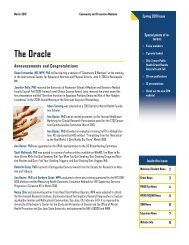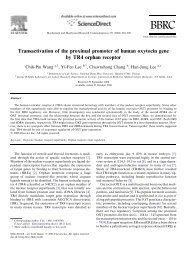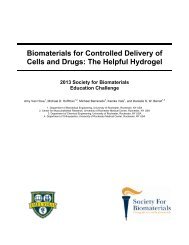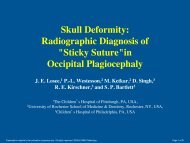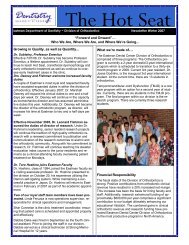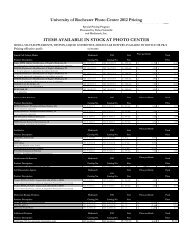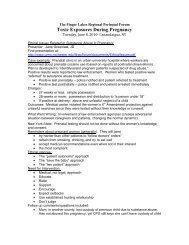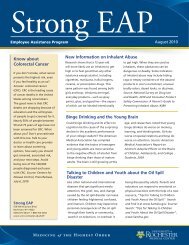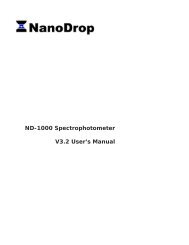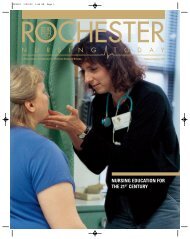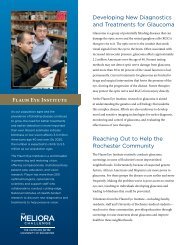Fall/Winter 2006 - University of Rochester Medical Center
Fall/Winter 2006 - University of Rochester Medical Center
Fall/Winter 2006 - University of Rochester Medical Center
Create successful ePaper yourself
Turn your PDF publications into a flip-book with our unique Google optimized e-Paper software.
treatments from the discoveries <strong>of</strong> basic<br />
science. <strong>Rochester</strong> is one <strong>of</strong> four institutions<br />
to get an initial CORT grant, an<br />
award that was based on the potential<br />
for dramatic impact on specific diseases<br />
and the readiness to test treatments in<br />
human trials.<br />
<strong>Rochester</strong>’s CORT project has<br />
three major segments: meniscal injuries<br />
and the development <strong>of</strong> osteoarthritis,<br />
age-related decline in fracture healing,<br />
and segmental bone loss in trauma. The<br />
treatment targets are signaling pathways<br />
that play critical roles in controlling<br />
skeletal cells, in particular, transforming<br />
growth factor-beta (TGF-beta) and<br />
ligases called Smurf 1 and Smurf 2.<br />
Rosier is leading the study <strong>of</strong><br />
injuries to the meniscus and its consequences.<br />
In studies in mice, the research<br />
team has found that over-expression <strong>of</strong><br />
one <strong>of</strong> the Smurf enzymes in cartilage<br />
could cause a form <strong>of</strong> osteoarthritis.<br />
“One <strong>of</strong> the Smurfs not normally<br />
expressed in healthy cartilage is turned<br />
on and it blocks the TGF-beta signals<br />
that help maintain the health <strong>of</strong> the<br />
cartilage,” Randy Rosier said. “We found<br />
that after meniscal injury, the Smurf is<br />
turned on in the cartilage adjacent to<br />
the injury. We think people who have<br />
high expression <strong>of</strong> it after the injury may<br />
Regis O’Keefe,<br />
M.D., Ph.D.<br />
be the ones who get arthritis.”<br />
As part <strong>of</strong> the project, tissue will<br />
be taken from patients who have torn<br />
cartilage for studies <strong>of</strong> gene expression.<br />
The patients also will have sophisticated<br />
quantitative MRIs that can detect the<br />
earliest loss <strong>of</strong> cartilage or structure.<br />
“About 40 percent <strong>of</strong> patients with<br />
meniscal injuries develop arthritis.<br />
Within a few years, we’ll know who they<br />
are and we can look back at the gene<br />
expression,” Rosier said. “We hope to<br />
develop a model that allows us to predict<br />
who will get arthritis. Then we can help<br />
with a therapeutic strategy.”<br />
The team also envisions the use<br />
<strong>of</strong> growth factor or a gene therapy that<br />
could prevent the development <strong>of</strong><br />
arthritis.<br />
Healing and revitalizing bone<br />
Regis O’Keefe, M.D., Ph.D. (R ’92, MS ’00,<br />
PhD ’00), pr<strong>of</strong>essor <strong>of</strong> Orthopaedics and<br />
director <strong>of</strong> the <strong>Center</strong> for Musculoskeletal<br />
Research, is the principal<br />
investigator for the CORT project’s<br />
second segment, an investigation <strong>of</strong><br />
fracture healing.<br />
Broken bones in the elderly do not<br />
heal as well or as quickly as the broken<br />
bones <strong>of</strong> children. There are several<br />
causes for the lessening <strong>of</strong> the ability to<br />
heal. But O’Keefe and his lab team have<br />
found a series <strong>of</strong> genes expressed at<br />
10<br />
ROCHESTER MEDICINE



